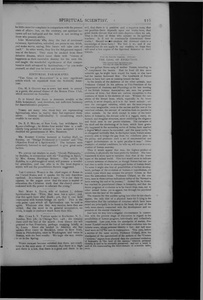The Goal of Evolution
“Her’ prentice han’ she tried on man, |
So the gallant Burns sang of mother Nature, intending to compliment the lassies. Had he lived till this more scientific age, he might have stayed his hand, or else have had the lassies fashioned first. The handiwork of Nature seems to have lost care or cunning toward the last.
In the details of the skeletons of the other animals, says Professor Cleland (in his address as Vice President of the Department of Anatomy and Physiology at the late meeting of the British Science Association>. one sees the greatest precision of form; but there are various exceptions to this neatness of finish in the skeleton of man. Witness the variations of the breast bone, which, especially in its lower portion, is never shapely, as it is in the lower animals; witness the coccygeal vertebra, which are the most irregular structures imaginable; even in the sacrum and the rest of the vertebral column, the amount of variation finds no parallel in other animals. In the skull, except in some of the lower forms of humanity, the dorsum sella is a ragged, warty, deformed, and irregular structure, never exhibiting the elegance and finish seen in our poorer relations. The curvature of the skull and the shortening of its base, which have gradually increased in the ascending series of forms, have reached a degree which cannot be exceeded; and the nasal cavity “is so elongated vertically that, in the higher races. Nature seems scarcely able to bridge the gap from the cribriform plate to the palate, and produces such a set of unsymmetrical and rugged performances as is quite peculiar to man.” Other examples of similar conditions, he tells us, will occur to even student of human anatomy.
Thus it would appear that man. the highest product of evolution, is physically the least perfectly finished. His bony framework is more open to variation than that of the lower types of the animal world. This fact would seem to indicate a certain newness of character, as though Nature had not yet had time to settle down to stereotyped forms of human detail. To some it might also hint of possibilities of further development, perhaps of the evolution of human or superhuman, yet animal, types which may surpass the present human as that does the antecedent brute. Professor Cleland, on the contrary, sees in them curious indications rather of the “formative force nearing the end of its journey.” Animal life, he thinks, has reached its preordained climax in humanity, and that the future progress of evolution is to be traced from man, not to other animal forms yet to appear, but through his psychical nature into the land of the unseen.
The reasons for this sudden spring into ether do not clearly appear, the only hint of a physical basis for it lying in the observation that the variations of structure which have been noted are principally to be found in the head, the part of the body most closely connected with the development and expression of the mental character.
Just here we may note a singular circumstance in connection with the present stage of discussion in regard to the possibilities of human progress, individually and collectively considered. Last year, from the standpoint of matter, Professor Tyndall traced the fine of individual evolution into the infinite azure, whose personal identity is lost and half mankind were set by the ears in consequence. This year, before a section of the same society. Professor Cleland. from the standpoint of the speculations of the authors of the “Unseen Universe,” argues from physical data the continued evolution of humanity in “the land of the unseen,” wherein personal identity is said to be eternally preserved and not a word is said of his transcending the strict domain of scientific inference.
The Poetic Clairvoyance
What is the poet’s condition when writing? If Shakspere called it a “fine frenzy,” a modern psychologist would be quite as likely to say it is a kind of clairvoyance. The poet is a medium, and he has always recognized himself as such ever since and long before the invocation which begins the great early epic. He holds the pen, and the divinity, the muse, the inspiration, the genius, the spirit-influence—what ever the time may choose to call it—shapes the characters. The difference is this: In the “medium,” commonly so-called, the mechanical process of writing is automatically performed by the muscles in obedience to an impulse not recognized as proceeding from the will. In poetical composition the will is first called in requisition to exclude interfering outward impressions, and alien trains of thought. After a certain time the second state of adjustment of the poet’s double conscious ness (for he has two states, just as somnambulists have) sets up its own automatic movement with its special trains of ideas and feelings in the thinking and emotional centres. As <... continues on page 3-205 >
Editor's notes

